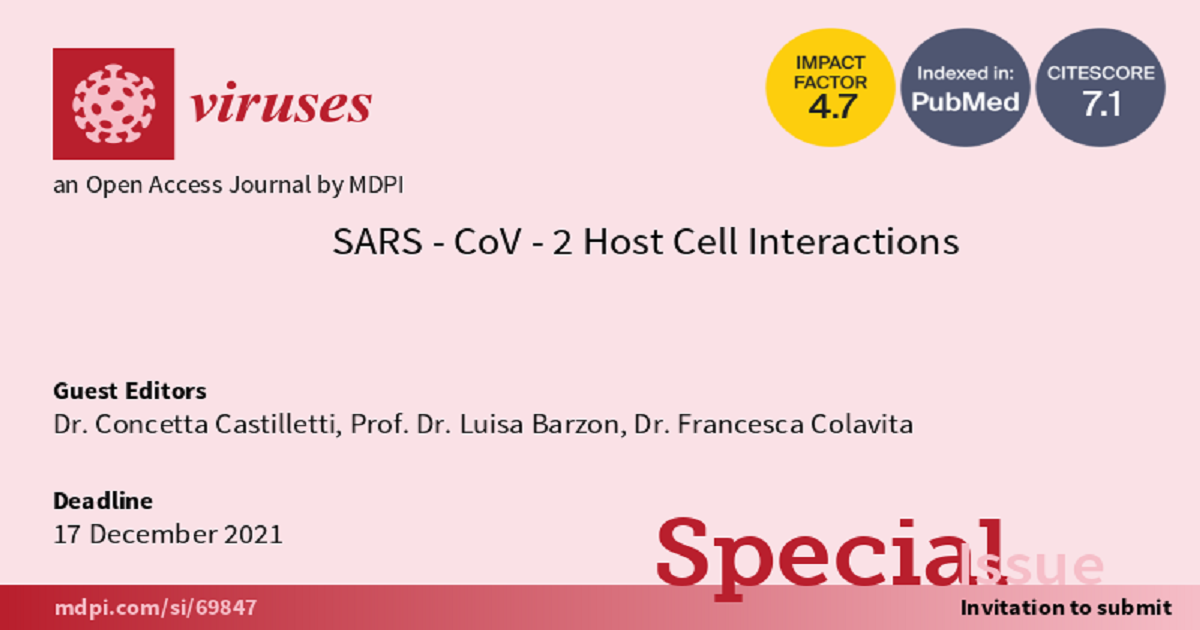SARS-CoV-2 Host Cell Interactions
A special issue of Viruses (ISSN 1999-4915). This special issue belongs to the section "SARS-CoV-2 and COVID-19".
Deadline for manuscript submissions: closed (17 December 2021) | Viewed by 1386281

Special Issue Editors
Interests: Emerging/re-emerging viral infections; host-pathogen interactions; innate immunity; mechanisms of IFN induction and regulation of IFN stimulated genes; design and validation of innovative diagnostic methods; molecular epidemiology of viruses; biosafety and field laboratory
Interests: surveillance, diagnosis, and pathogenesis of emerging vector-borne viral infections; pathogenesis, diagnosis, and prevention of human papillomavirus-related diseases; investigation of virus–host interactions; development of patient-specific models of human susceptibility to viral infections; application of innovative molecular methods in infectious disease diagnosis
Special Issues, Collections and Topics in MDPI journals
Interests: Emerging viruses; vector-borne infections; viral haemorrhagic Fevers; antibody response; antiviral innate immunity; virus-host interactions; viral shedding; diagnostic methods; Biosafety
Special Issue Information
Dear Colleagues,
The current coronavirus disease 2019 (COVID-19) pandemic caused by severe acute respiratory syndrome coronavirus-2 (SARS-CoV-2) is a global public health problem due to the relatively easy person-to-person transmission and the current lack of effective antiviral therapy. However, the exact molecular mechanisms of SARS-CoV-2 pathogenesis remain largely unknown.
Viruses are obligate intracellular parasites, entirely dependent on host cell machinery for their replication. In fact, they interact with the host machinery and alter cellular pathways to enhance their survival and replication. Part of this process is based on the inhibition of the cellular proteins that play a role in antiviral response and cell duplication. Some viruses directly divert key proteins from these pathways to promote their own replication.
Characterizing how SARS-CoV-2 takes over the operation of host cell machinery while disrupting cellular antiviral response will greatly improve our understanding of the pathophysiology of SARS-CoV-2 infection and will help to identify useful drug targets.
This Special Issue invites articles and expert reviews in the field of virus–host interactions to illustrate the current knowledge about virus–human cell interactome and the related strategies used by SARS-CoV-2 to exploit the host cell machinery and subvert cellular networks. Articles with an emphasis on the mechanisms by which SARS-CoV-2 subverts the antiviral response and triggers cytokine storms, which represent a powerful resource in the pursuit of therapeutic interventions, are particularly welcome.
Dr. Concetta Castilletti
Prof. Dr. Luisa Barzon
Dr. Francesca Colavita
Guest Editors
Manuscript Submission Information
Manuscripts should be submitted online at www.mdpi.com by registering and logging in to this website. Once you are registered, click here to go to the submission form. Manuscripts can be submitted until the deadline. All submissions that pass pre-check are peer-reviewed. Accepted papers will be published continuously in the journal (as soon as accepted) and will be listed together on the special issue website. Research articles, review articles as well as short communications are invited. For planned papers, a title and short abstract (about 100 words) can be sent to the Editorial Office for announcement on this website.
Submitted manuscripts should not have been published previously, nor be under consideration for publication elsewhere (except conference proceedings papers). All manuscripts are thoroughly refereed through a single-blind peer-review process. A guide for authors and other relevant information for submission of manuscripts is available on the Instructions for Authors page. Viruses is an international peer-reviewed open access monthly journal published by MDPI.
Please visit the Instructions for Authors page before submitting a manuscript. The Article Processing Charge (APC) for publication in this open access journal is 2600 CHF (Swiss Francs). Submitted papers should be well formatted and use good English. Authors may use MDPI's English editing service prior to publication or during author revisions.
Keywords
- virus-host cell interactions
- interactome
- innate immunity
- interferon
- cytokine storm
- inflammasome
Related Special Issue
- Coronaviruses in Viruses (97 articles)







